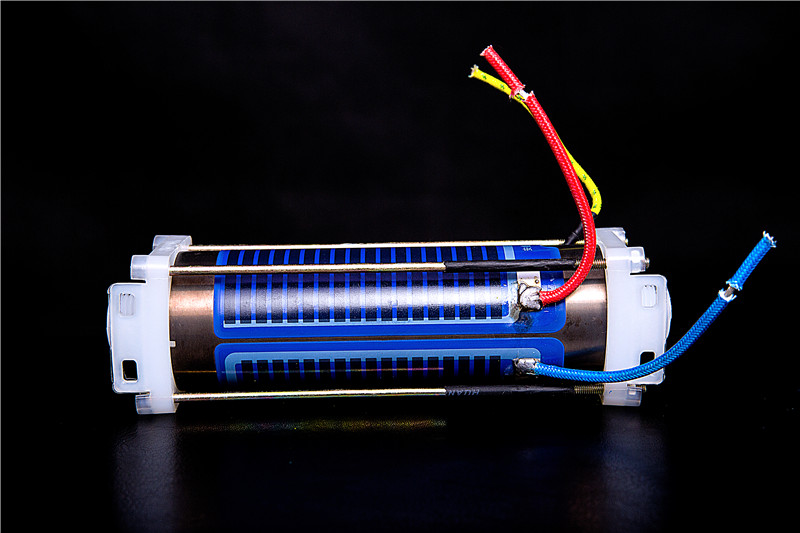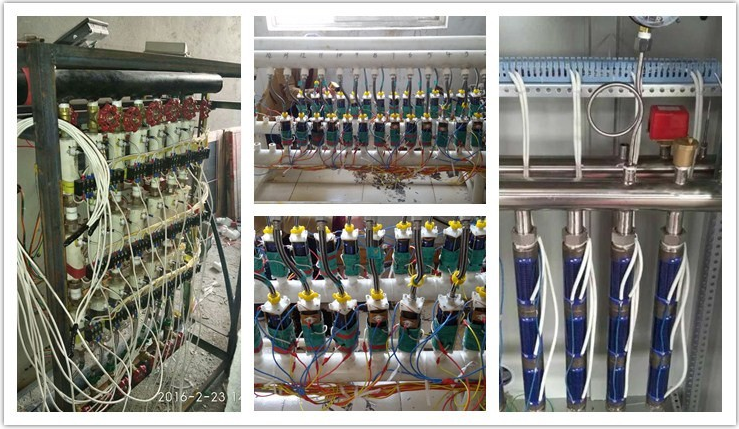Molybdenum-containing minerals are many, only four major molybdenum minerals: molybdenite, molybdenum ore, calcium, iron acid mine molybdenum (Mo Hua Hua molybdenum and iron) and lead acid mine molybdenum (Mo Cai galena). Among them, more than 98% of the world's total mining is molybdenum ore. The other three minerals are only secondary oxidation products of molybdenum ore, often associated with molybdenite deposits, but rarely constitute industrial mining value. Independent deposit.
The ore-forming process of molybdenite is about the following: during the evolution of magma, molybdenum and halogen elements are tightly combined to form halides, which are highly volatile. They could not crystallize during the magma period. After the pegmatite period, they even left a little in the granitic pegmatite, but they were not of industrial value. Due to the high temperature in the ground and the huge vapor pressure at this time, most of the molybdenum halide is transferred into the vaporized hydrothermal fluid. Molybdenite is crystallized under the action of gasification hydrothermal fluid of internal force mineralization. Since molybdenum to sulfur having a strong chemical affinity, when mineralization, hydrothermal sulfur will first bind to molybdenum generating molybdenite, until only residual sulfur and copper, lead metal sulphide mineral composition. Therefore, molybdenite is often present in high- and medium-temperature hydrothermal deposits, and is rare in low-temperature hydrothermal deposits. Copper-lead sulfide minerals are usually found in medium- and low-temperature hydrothermal deposits, which are rare in high-temperature hydrothermal deposits. At the stage of external ore-forming, due to the stable chemical nature of molybdenite, little oxidation and secondary molybdenum minerals are formed, and some molybdenum halo is formed only after long-term weathering, leaving some clues for geological prospecting, but it cannot be formed. A deposit of industrial value. There are many methods for dividing molybdenum deposits.
1. According to the geological genesis of the deposit
The molybdenum deposits mainly include high- and medium-temperature hydrothermal deposits and skarn deposits.
Mo-containing high-temperature hydrothermal deposits, the ore are usually located in an acidic granite, granodiorite or near the surrounding rock, the product is usually alteration greisens, albite and so on. The ore structure is usually coarse, and the ore body is often filled in various cracks of the intrusive rock to form veins or veins; or formed into a block or disseminated shape by metasomatism. The gangue minerals that are symbiotic with molybdenum ore are: quartz , mica , and amphibole. Metal minerals mainly include black tungsten ore, cassiterite , and a small amount of chalcopyrite. It is often a porphyry molybdenum deposit.
In the medium-temperature hydrothermal molybdenum-bearing deposits, the ore bodies usually invade the acidic rocks, but there are many kinds of parent rocks and surrounding rocks. The alteration products are usually silicified, quartzized, and sericitized. The ore body shape is similar to the high temperature, but the ore crystal grain size is slightly thinner than the high temperature. Molybdenite symbiotic gangue minerals include: quartz, sericite and the like; metal minerals are: chalcopyrite, pyrite, galena, sphalerite and the like.
Skarn-type molybdenum deposits are also mainly distributed in acidic rocks, while medium-acid or alkaline rocks are often unrelated to molybdenum mineralization. The gangue minerals that are symbiotic with molybdenite are: calcium aluminum garnet, calcium iron garnet, diopside , Fushan stone, wollastonite, etc.; metal minerals are mainly: scheelite , pyrite, chalcopyrite Wait.
2, according to the structure of the ore body can be divided
Vein, venous, fine veins and block.
3. Divided by ore structure
Porphyry molybdenum deposit, porphyry copper-molybdenum deposit and skarn molybdenum deposit. This method is more intuitive than the ore body structure.
4. Division in the study of mineral processing technology
Often used to the main minerals of molybdenum or by-product molybdenum ore.
The most valuable minerals recovered from the main molybdenum mines are molybdenum ore, but valuable minerals with associated and comprehensive recovery, such as scheelite, chalcopyrite, pyrite, magnetite, etc., are not excluded. The molybdenum metal reserves of the main molybdenum ore account for about 2/3 of the total reserves of the phase. The world's large molybdenum mines such as Claymax, Henderson, Quartz Mountain, Ndak, McCain, (China's) Qinchuan, Daheishan, Jinduicheng, Yangjiazhangzi, Lanjiagou, etc. The main production of molybdenum deposits.
[next]
The by-product molybdenum ore is a molybdenum ore that is accompanied by the recovery of other major valuable components at the same time, and contains molybdenum of about 0.01%. Common copper-molybdenum ore, tungsten-molybdenum ore, uranium -molybdenum ore, etc. The vast majority of them are copper-molybdenum ore, which accounts for about one-third of the total reserves of molybdenum and about half of the world's total output. The world's large copper-molybdenum mines include: Chuquicamalon, Brenda, Haimont, Balhas, China's Dexing, Baoshan, etc., all of which are copper-molybdenum ore by-product molybdenum deposits.
5. Industrial ore classification
In terms of habit, people often divide the mineral deposits, ore structure and structure, and the valuable components of ore into industrial deposits. Whether this is scientific and rigorous and needs to be studied.
Ore is classified into three industrial types of molybdenum ore according to the genetic characteristics:
(1) Hydrothermal vein type quartz molybdenum ore (similar to the porphyry molybdenum deposit introduced earlier). It is a high-temperature warm liquid cause, high in molybdenum, and the mineral composition is generally simple. In addition to molybdenum ore, there may be associated with black tungsten ore, stibnite , cassiterite and a small amount of sulfide. The gangue minerals are quartz, muscovite, fluorite , topaz and beryl.
(2) fine veins impregnated molybdenum, copper molybdenum ore. Copper and molybdenum are symbiotic in the ore. When the copper content is low, the main molybdenum ore is produced, and copper is a by-product; when the copper content is high, it is a by-product molybdenum ore. The ore is in the form of fine veins and disseminated structures. It is the most important type of molybdenum ore, and 2/3 of the world's molybdenum production comes from such ore. The main metal minerals are molybdenite, yellow tin ore, pyrite, and often contain gold and antimony . Valuable components such as gallium .
(3) The skarn type molybdenum ore is as described above. Such ore is rare abroad, and there are reports of Morocco's Ajgur, the former Soviet Union's Terne-Auz. In China, such ore is the most widely distributed, and there are a large number of skarn molybdenum resources in Luanchuan, Jinduicheng and Yangjiazhangzi.
According to the geological origin of the deposit, the structure and structure of the ore, the structure and structure of the rock, China has six metallogenic belts of molybdenum:
(1) Heilongjiang-Jilin metallogenic belt: mainly skarn type, porphyry copper-molybdenum ore and polymetallic deposits. Such as: Daheishan, Duobaoshan, Cuihongshan.
(2) Qinling-Dabieshan molybdenum metallogenic belt: This is the largest molybdenum metallogenic belt in China, and proven reserves account for two-thirds of the total reserves. Mainly skarn type and porphyry molybdenum type. The main mining areas are: Jinduicheng, Huanglongpu, Sandaotun-Nannihu, Shangfanggou, Luotuoshan, Lushan, Qiucunwan and other giant and large deposits.
(3) North Fujian-Liaoxi metallogenic belt: It corresponds to the Qinling-Dabie mountain metallogenic belt and constitutes the north and south edge of North China. The main deposits from west to east are: Houyi, Dawan, Sanyizhuang, Cuoyugoumen, Yangjiazhangzi, Lanjiagou, Xintaimen, Xiaosigou, Dongjiagou, Dazhuangke, Xiaojiayingzi.
(4) Molybdenum metallogenic belt in the middle reaches of the Yangtze River: porphyry copper-molybdenum ore is mainly composed of Tongshankou, Fengshan, Yangcangling, Chengmenshan, Dexing, Tongshan and Taiping.
(5) Coastal metallogenic belt of Zhejiang, Fujian and Guangdong: mainly copper-molybdenum (Hunan), tungsten-molybdenum (Jiangxi, Yuebei) and ferromolybdenum (Zhejiang). The main deposits are: Chilu, Xingluokeng, Shizhuyuan Baoshan, Xihua Mountain, Qikeng, Dalongshan, Baishiyu and Shipingchuan.
(6) Sanjiang (Nujiang, Minjiang, Jinshajiang) metallogenic belts: mainly porphyry copper-molybdenum deposits, the main deposits are Yulong, Geyi Xianyu and Machangjing. The main types and characteristics of molybdenum deposits in China are shown in the table below.
[next]
Table type and main characteristics of molybdenum
Deposit type | Ore shape | Content (%Mo) | Comprehensive utilization of elements | Main mineral combination | Wall rock alteration | Cause | Deposit example |
Ore mineral | Gangue mineral |
Porphyry molybdenum deposit | Fine vein impregnated molybdenum ore | Lentil | 0.2~0.01 | Re, S, Se, Te, Cu, Fe | Molybdenite, pyrite, chalcopyrite, magnetite, sphalerite, galena, hematite, pyrrhotite | Ortho-feldspar, quartz, sericite, biotite, petite, muscovite, fluorite, epidote, etc. | Anshan shale, rhyolite porphyry, potash, biotitization, horn rock, chlorite, etc. | High-medium temperature hydrothermal deposit | Jinduicheng, Luanchuan |
Porphyry copper-molybdenum ore | | Cu<1% Mo<0.3% | Cu, Mo, S, Fe, Co, Re, Pb, Zn, V | Chalcopyrite, pyrite, molybdenite, porphyrite, galena, sphalerite, stibnite | Quartz, potassium feldspar, sericite, calcite , chlorite, iron dolomite | Black mica-K-long petrochemical potassium-rich felsian lithology and biotite calcification quartz-silicaization | High school warm liquid | Dexing, Jiangxi, Laoshan, Henan |
Granite porphyry molybdenum ore | Isometric | | Re, W, Se, Te, S | Molybdenite, pyrite, chalcopyrite, cassiterite, stibnite, magnetite | Feldspar, quartz, muscovite, biotite, fluorite, beryl, apatite, topaz | Yunying lithification and sericitization | High school warm liquid | Jinduicheng, Yangjiazhangzi, fallen |
Porphyry tungsten-molybdenum ore | Lenticular (pulse) ribbon | Poor quality | W, Mo, Bi | Scheelite, molybdenite, a small amount of pyrite, pyrrhotite, chalcopyrite | Feldspar, quartz, calcite, chlorite, apatite, monazite, etc. | Potassium Petrochemical, Silicification, Green Curtain Petrochemical, Carbonation, Yili Petrochemical | Hot liquid | Jiangxi Chuling, Dabaoshan |
Skarn molybdenum deposit | Single molybdenum type | Layered, layered, irregular | 0.1~0.3 Large scale | | Molybdenite, pyrite, a small amount of chalcopyrite, pyrrhotite, arsenopyrite, yellow lead ore, sphalerite | In addition to skarn minerals, there are calcite, chlorite, fluorite | 矽å¡å²©åŒ–, K. long petrochemical, sodium long petrochemical | Hot liquid | Yang Jiazhangzi, Luanchuan |
Copper molybdenum type | Lenticular, layered, veinlike, lentil, cystic | Mo 0.12 Cu 0.24 | Cu, W, Pb, Zn, S, Re | Molybdenite, chalcopyrite, pyrite, magnetite, scheelite, galena, sphalerite, hematite | Quartz, biotite, hornblende, calcite, chlorite, diopside, garnet | Leica, lithification | Contact confession | Baoshan, Shilu, Mingrong, Fushan, Linjiang |
Tungsten, tin, molybdenum | Layered, layered | Mo: Bi is 1~20:1~3 | W, Bi, Mo, Sn, Cu | Scheelite, wolframite, molybdenite, stibnite, cassiterite, pyrite, pyrrhotite, chalcopyrite, etc. | Fluorite, garnet, diopside, Fushan stone, hornblende, feldspar | 矽å¡å²©åŒ–, Changhua Petrochemical, Yunying lithification, fluorite, etc. | Contact confession | Persimmon garden |
In order to satify our customer need for commercial vending machine and industrial equipment, we develop large power Thick Film Heating Element. It can realize 6000w on single Thick Film Heating Tube. And it is widely used in industrial field for water boiler and thermal exchange equipment.

Under the same conditions, Jieda products have many application advantages, such as large heating area, high he at conduction efficiency (≥98%), rapid thermal response (≥80~150 ℃/S), long working life (≥10000 hours) etc. Beside this Jieda has the advantages of continous R&D investment, independent printing method and mass production gurrantee.

50Mm Electric Heater
20Mm Stainless Steel Welding Heater,Stainless Steel Welding Heater,Welding Heater,Welding Rod Heater
XINXIANG JIEDA PRECISION ELECTRONICS CO.,LTD , https://www.gidaheater.com

